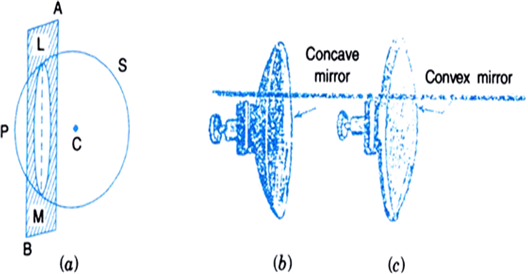Acids, Bases and Salts
What is a spherical mirror? What are the two different types of spherical mirrors?
Spherical mirror is a mirror whose reflecting surface is a part of a hollow sphere. The reflecting surface of the spherical mirrors may be curved inwards or outwards.
In Fig, S is a hollow glass sphere being cut by a plane AB. The section LPM of this spherical shell cut by the plane, forms a part of the sphere and is known as spherical surface.
If either side of this spherical surface is silvered, we get a spherical mirror. 
Spherical mirrors are of two types:
(i) Concave mirror: A spherical mirror, whose reflecting surface is curved inwards i.e., towards the centre of the the sphere is called as concave mirror. Concave mirror is silvered on the outer bulged surface and reflects light from the hollow inner surface. Figure (b) shows us a concave mirror.
(ii) Convex mirror: A spherical mirror is convex if it is silvered on the inner hollow surface and reflects light from the outer bulged surface. The reflecting surface of the convex mirror is curved outwards. Figure (c.) shows us the diagram for a convex mirror.
Sponsor Area
Some More Questions From Acids, Bases and Salts Chapter
What is meant by the optical image of an object?
What are real and virtual images? Can these images be obtained on a screen? Give reasons in support of your answer.
Give three points of differences between real and virtual images.
What is a mirror? Mention the different types of mirrors commonly used.
Define the following terms in connection with reflection of light:
Incident ray, reflected ray, point of incidence, normal, angle of incidence and angle of reflection.
State the laws of reflection of light.
Are the laws of reflection applicable to plane surfaces also valid for curved surfaces?
State the important properties of images formed by plane mirrors.
What is lateral inversion of an image ? What is the cause of lateral inversion?
What is a spherical mirror? What are the two different types of spherical mirrors?
Mock Test Series
Sponsor Area
NCERT Book Store
NCERT Sample Papers
Sponsor Area